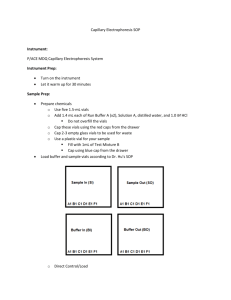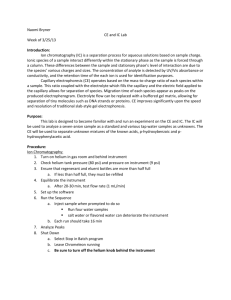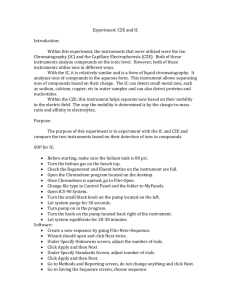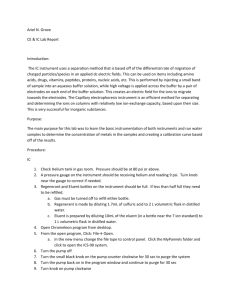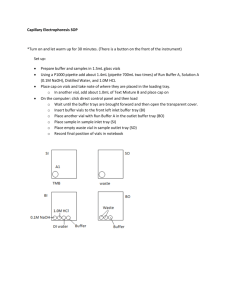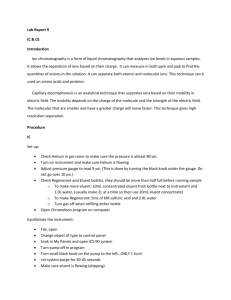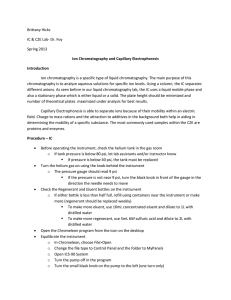Capillary Electrophoresis and IC
advertisement
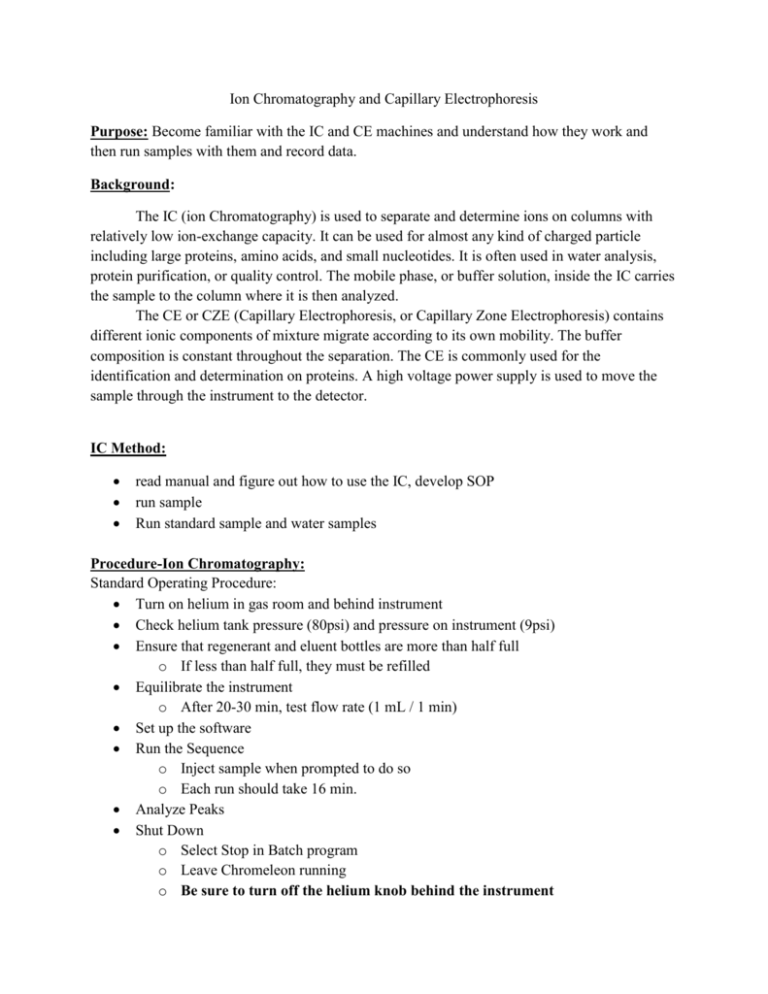
Ion Chromatography and Capillary Electrophoresis Purpose: Become familiar with the IC and CE machines and understand how they work and then run samples with them and record data. Background: The IC (ion Chromatography) is used to separate and determine ions on columns with relatively low ion-exchange capacity. It can be used for almost any kind of charged particle including large proteins, amino acids, and small nucleotides. It is often used in water analysis, protein purification, or quality control. The mobile phase, or buffer solution, inside the IC carries the sample to the column where it is then analyzed. The CE or CZE (Capillary Electrophoresis, or Capillary Zone Electrophoresis) contains different ionic components of mixture migrate according to its own mobility. The buffer composition is constant throughout the separation. The CE is commonly used for the identification and determination on proteins. A high voltage power supply is used to move the sample through the instrument to the detector. IC Method: read manual and figure out how to use the IC, develop SOP run sample Run standard sample and water samples Procedure-Ion Chromatography: Standard Operating Procedure: Turn on helium in gas room and behind instrument Check helium tank pressure (80psi) and pressure on instrument (9psi) Ensure that regenerant and eluent bottles are more than half full o If less than half full, they must be refilled Equilibrate the instrument o After 20-30 min, test flow rate (1 mL / 1 min) Set up the software Run the Sequence o Inject sample when prompted to do so o Each run should take 16 min. Analyze Peaks Shut Down o Select Stop in Batch program o Leave Chromeleon running o Be sure to turn off the helium knob behind the instrument Lab Procedure: Run four different water samples o Do not run salt water or flavored water as this will harm the instrument! Run two samples per day Procedure-Capillary Electrophoresis: Chemicals Required: Capillary Performance Test Mixture B (mixture of p-hydroxybenzoic acid and phydroxyphenylacetic acid) Capillary Performance Run Buffer A (pH 8.35) Capillary Electrophoresis System Solution A (0.1 M NaOH) Distilled water 1.0 M HCl Solution All chemicals should be stored in the chemical refrigerator or under the instrument Standard Operating Procedure: Turn on the instrument Let it warm up for 30 minutes Read Dr. Hu’s SOP while the instrument is warming up Prepare and label chemicals Load buffer and sample vials according to Dr. Hu’s SOP Build Method using Dr. Hu’s SOP o Time Program: Rinse 1.0 min (20 psi, forward pressure) from 1.0 M HCl to Waste Rinse 1.0 min (20 psi, forward pressure) from distilled water to Waste Rinse 2.0 min (20 psi, forward pressure) from 0.1 M NaOH to Waste Rinse 1.0 min (20 psi, forward pressure) from distilled water to Waste Rinse 2.0 min (20 psi, forward pressure) from Buffer A to Waste Inject (0.5 psi pressure, 10 seconds) from sample vial (Test Mixture B) to Waste Separate at 0.0 min (Duration: 7 min, Voltage: 25 KV, Ramp: 0.17 min) from Run Buffer A (BI) to Run Buffer A (BO) Autozero at time 1.50 min Stop data at 7.0 min Rinse 1.0 min at time 8.0 min (20 psi, forward pressure) from distilled water to Waste Save and Run Method Save and print electropherogram with report If you are the last group, exit the program and turn off the instrument o Remove all vials, except the buffer vials o Load the trays before turning off the instrument Data Analysis: Use peak area to calculate the percentage of each compound Predict which is p-hydroxybenzoic acid and which is p-hydroxyphenylacetic acid Data: The results are in my lab notebook. Conclusion: The IC and the CE were relatively easy to use after becoming acquainted with their procedure. For the IC we ran a seven anion standard and then the standards and a sample. After running all of these, the graphs were then analyzed and compared to one another to find similar structures of molecules. The samples were water taken from the different chemistry labs and the nearby water fountain. They all appeared to high levels of chloride and phosphate. For the CE many standard were run and a unknown called mixture B.
